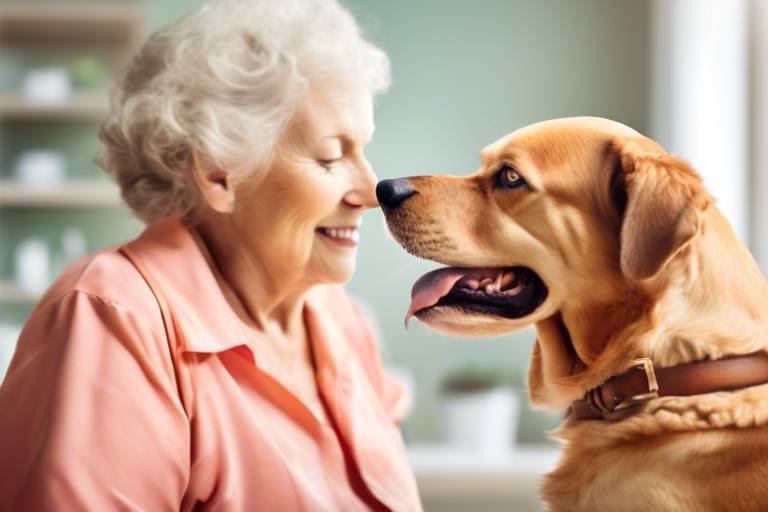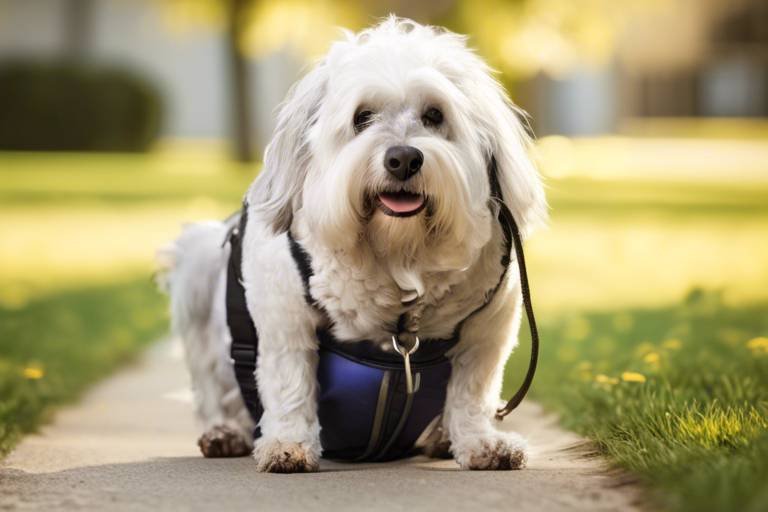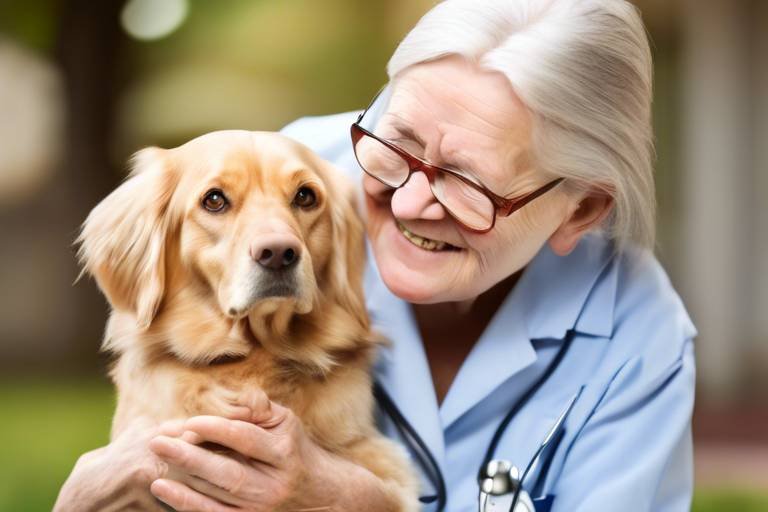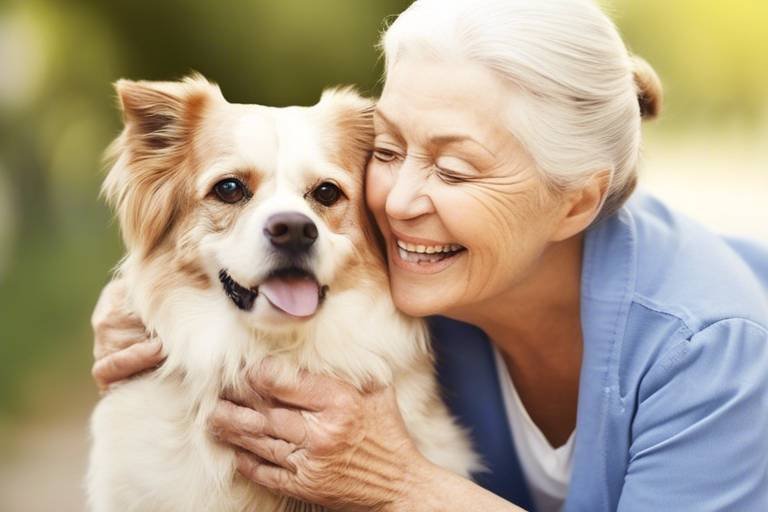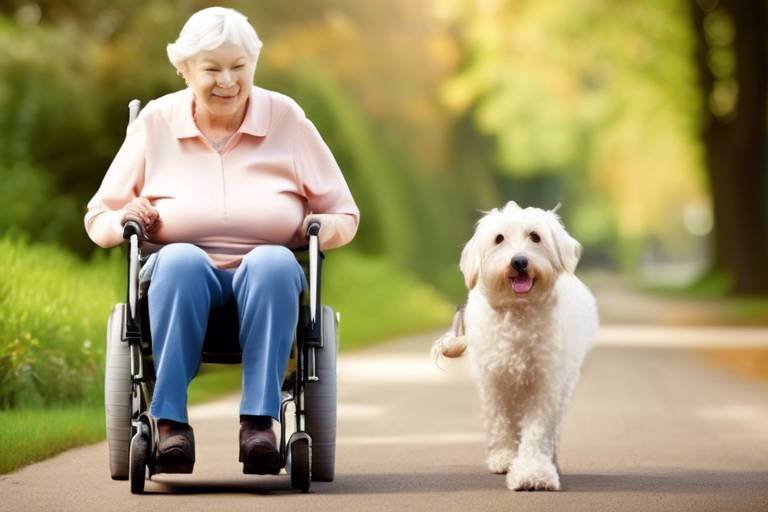Signs of Pain in Senior Dogs - What to Watch For
As our furry companions age, they can develop various health issues that lead to discomfort and pain. Recognizing the signs of pain in senior dogs is crucial for their well-being. Just like humans, dogs can’t always tell us when they’re hurting, so it’s up to us to be vigilant. This article explores the various indicators of pain in senior dogs, helping owners recognize subtle signs to ensure their pets receive timely care and relief from discomfort.
Senior dogs often exhibit noticeable behavioral changes when in pain. These shifts may include increased irritability, withdrawal from social interactions, or changes in their usual routines. For instance, a dog that once loved to play fetch may suddenly prefer to lie down and rest. Understanding these shifts is crucial for identifying discomfort and ensuring appropriate responses from their owners. If your once-active pup is now less enthusiastic about walks or playtime, it might be time to investigate further.
Recognizing physical symptoms is vital in detecting pain in senior dogs. Some key indicators include limping, stiffness, and changes in posture. For example, if you notice your dog struggling to get up after lying down or hesitating to jump onto the sofa, these could be signs of discomfort. Additionally, keep an eye on their body language; a dog that is hunched over or has a tense posture may be experiencing pain. It's essential for dog owners to be proactive in observing these signs and seeking veterinary advice when necessary.
A decrease in appetite can be a significant indicator of pain in senior dogs. When dogs are in pain, they may not feel like eating, which can lead to further health complications. This section discusses how pain can affect their eating habits and overall health. If your dog is leaving their food uneaten or seems disinterested in their favorite treats, it’s important to consider that they might be experiencing discomfort. Remember, a dog’s appetite is often a reflection of their overall health, so any significant changes should not be ignored.
When dogs experience pain, they may become reluctant to eat their favorite foods. This behavior can be particularly concerning for owners who know their pets typically enjoy mealtime. Understanding this behavior can help owners identify underlying issues that require attention. If your senior dog is consistently turning away from food, it may indicate that they are dealing with dental issues, gastrointestinal problems, or other painful conditions. It’s always wise to consult your veterinarian if you notice this change.
Pain can sometimes lead to increased thirst in senior dogs. This section explores how discomfort may influence their hydration needs and drinking habits. While increased thirst can be a sign of various health issues, it can also stem from pain, especially if your dog is taking medications that affect their hydration. Monitoring your dog's drinking habits can provide insight into their overall health and comfort levels.
Pain can disrupt a senior dog's sleeping patterns, leading to restlessness or excessive sleeping. Just like humans, dogs need quality sleep to recuperate and maintain their health. If you notice your dog struggling to find a comfortable position or waking frequently during the night, it may be a sign that they are in pain. This section emphasizes the importance of monitoring these changes for potential pain indicators. A well-rested dog is usually a happy dog, so any disturbances in their sleep should prompt further investigation.
Vocalizations such as whining, growling, or barking can indicate pain in senior dogs. Dogs often use their voices to communicate their feelings, and understanding these sounds can be crucial for identifying discomfort. If your dog suddenly becomes more vocal than usual, it might be their way of telling you something isn’t right. This section explains how these sounds can be crucial for identifying discomfort, allowing owners to respond appropriately.
Whining is often a dog's way of expressing discomfort or distress. It can be frustrating for owners who may not understand why their dog is whining. This subheading delves into the significance of whining as a potential sign of pain in senior dogs. If your dog is whining more frequently, especially when attempting to move or during certain activities, it’s time to pay attention and consider the possibility of pain.
Growling or barking may indicate pain or irritation. This section discusses how these vocalizations can serve as important signals for owners to investigate further. If your normally docile dog suddenly growls when touched, it could be a clear indicator that they are experiencing discomfort. Don’t overlook these vocal cues; they are your dog's way of asking for help.
Mobility issues are common in senior dogs experiencing pain. These changes can manifest in various ways, such as reluctance to engage in physical activities or difficulty getting up from a resting position. This section highlights how changes in movement and activity levels can be indicators of underlying discomfort. If your dog is hesitating to go for walks or seems to struggle with their usual pace, it’s essential to take note and consult with a veterinarian.
Limping and stiffness are clear signs that a dog may be in pain. If you notice your dog limping after a walk or showing signs of stiffness when getting up, these symptoms should not be ignored. This subheading discusses how to recognize these symptoms and their implications for a senior dog's health. Regular check-ups with your vet can help address these issues before they escalate.
Many senior dogs struggle with stairs due to pain. If your dog is suddenly hesitant to go up or down stairs, it could be a critical warning sign for owners to consider. This section explains how difficulty navigating stairs can indicate underlying issues that need attention. Consider making adjustments in your home, like using ramps or baby gates, to help your dog navigate their environment safely.
- What are the most common signs of pain in senior dogs? Look for changes in behavior, appetite, mobility, and vocalizations.
- How can I help my dog if they show signs of pain? Consult your veterinarian for a thorough examination and appropriate treatment options.
- Are there any at-home remedies for pain relief? Some remedies may include warm compresses or joint supplements, but always check with your vet first.
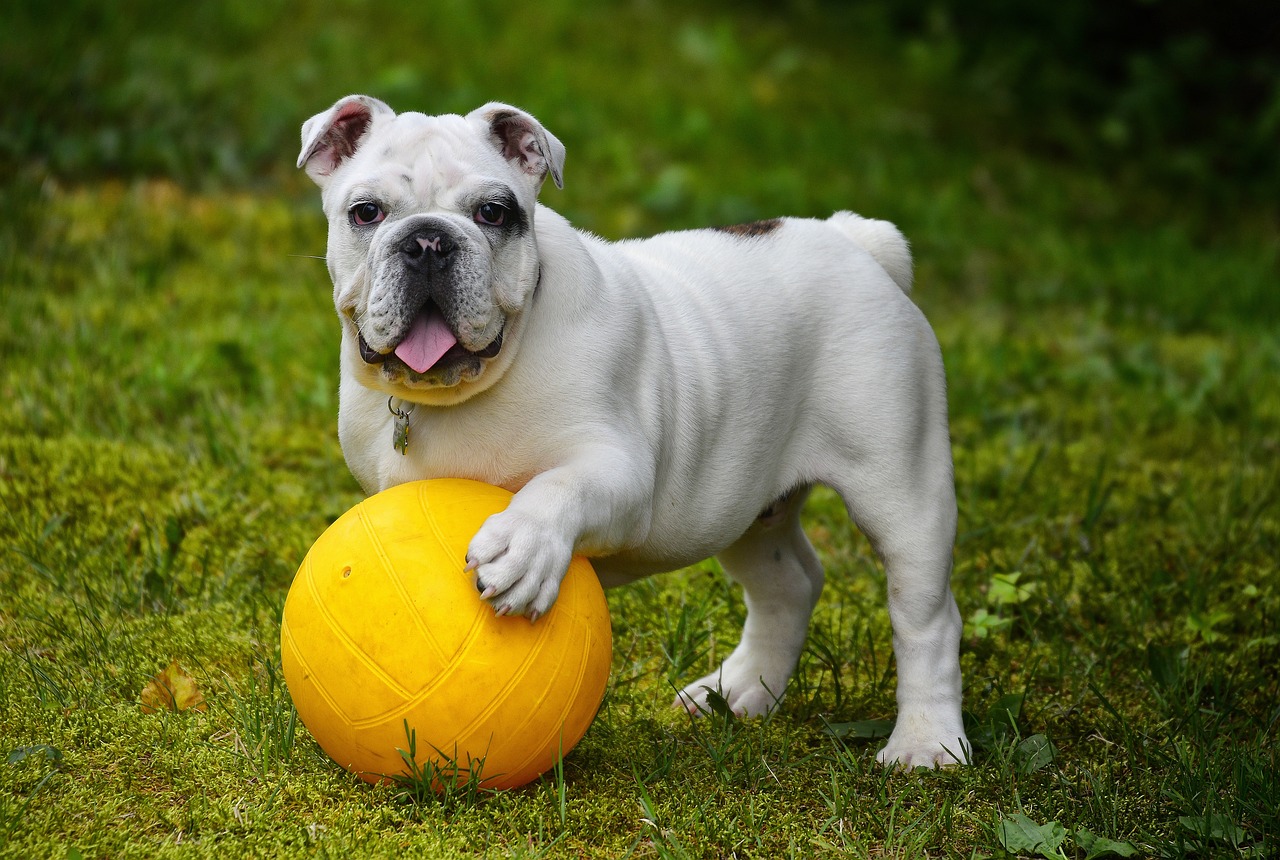
Common Behavioral Changes
As our furry companions age, their bodies and minds undergo significant transformations, often leading to subtle yet impactful behavioral changes. These shifts can be a clear indication that your senior dog is experiencing discomfort or pain. It's essential for dog owners to be observant and responsive to these changes, as they can provide critical insights into their pet's well-being. For instance, you might notice your once playful pup becoming more withdrawn or irritable. This change in demeanor can be a sign that something isn't quite right.
One of the most common behavioral changes in senior dogs is an increase in agitation or restlessness. If your dog seems unable to settle down, pacing around the house, or frequently changing positions, it may be an indication of pain. Dogs often express their discomfort in ways that might not be immediately obvious to us, so it's crucial to pay close attention to their body language. For example, a dog that suddenly starts to avoid certain activities, like playing fetch or going for walks, might be trying to tell you that they are in pain.
Another behavioral change to watch for is a decreased interest in social interactions. Senior dogs may become less enthusiastic about engaging with family members or other pets. This withdrawal can be distressing for both the dog and their owners, as it feels like a loss of the connection you once shared. It’s important to recognize that this change might stem from discomfort rather than a change in personality. Sometimes, dogs will also exhibit signs of anxiety or fear that weren't present before, which can be linked to pain or discomfort.
Additionally, you may observe changes in their grooming habits. Senior dogs in pain might neglect their grooming, leading to a scruffy appearance. They may also avoid certain positions that make grooming difficult, such as lying on their side or back. This can be particularly telling if your dog has always been fastidious about their appearance. If you notice that your dog is not grooming themselves or seems to be avoiding certain areas of their body, it could indicate pain in those regions.
In summary, being aware of these common behavioral changes is crucial for any senior dog owner. By observing your dog's behavior closely and recognizing these signs, you can take the necessary steps to ensure they receive the care and relief they need. Remember, your dog relies on you to be their advocate, so stay alert to these subtle shifts in their behavior.

Physical Symptoms to Observe
Recognizing physical symptoms is vital in detecting pain in senior dogs. As our furry companions age, they may not always communicate their discomfort in ways we easily understand. Observing their physical behavior can provide critical insights into their health. Some key indicators of pain include limping, stiffness, and noticeable changes in posture. Each of these signs can be subtle or pronounced, and they often indicate that something isn't quite right.
For instance, if you notice your senior dog is limping, it could be a sign of arthritis or an injury. Limping often indicates that your dog is favoring a particular leg, which can suggest pain in that area. Stiffness, particularly after resting or during movement, is another common symptom. This stiffness can manifest as difficulty getting up from a lying position or a reluctance to engage in usual activities, such as playing or going for walks.
Additionally, pay attention to your dog's posture. A dog in pain may exhibit a hunched back or a lowered head, which can be a clear indication of discomfort. They might also adopt a more curled-up position when resting, as if trying to protect a painful area. These physical signs are not just fleeting moments; they are important clues that can guide you toward seeking veterinary assistance.
Another key aspect to consider is how your dog's mobility changes over time. You might notice that they are less eager to jump onto the couch or bed, or they may hesitate at the door, showing reluctance to go outside. This change in behavior can be alarming and should prompt an immediate evaluation of their health.
| Physical Symptoms | Possible Causes |
|---|---|
| Limping | Injury, arthritis, joint issues |
| Stiffness | Arthritis, muscle strain, injury |
| Changes in Posture | Pain, discomfort, neurological issues |
| Reluctance to Move | Pain, fatigue, weakness |
In conclusion, being vigilant about these physical symptoms can make a significant difference in your senior dog's quality of life. If you notice any of these signs, it's crucial to consult with your veterinarian as soon as possible. Early intervention can lead to better management of pain and improved overall health for your beloved pet.
- What are the most common signs of pain in senior dogs? Common signs include limping, stiffness, changes in posture, reluctance to move, and altered eating habits.
- How can I help my senior dog if I notice signs of pain? Consult your veterinarian for a thorough examination and discuss pain management options that may include medication, physical therapy, or lifestyle changes.
- Is it normal for senior dogs to be less active? While some reduction in activity can be normal with age, significant changes in behavior or mobility should be evaluated by a vet.
- Can pain in senior dogs be managed effectively? Yes, with proper diagnosis and treatment, many forms of pain in senior dogs can be managed to improve their quality of life.
Changes in Appetite
When it comes to our beloved senior dogs, a sudden decrease in appetite can be one of the most telling signs of pain or discomfort. Imagine how you would feel if you were in pain; the last thing on your mind would be food, right? This analogy holds true for our furry friends as well. Pain can manifest in various ways, and changes in eating habits are often the first indicators that something is amiss. Senior dogs may start to avoid their favorite meals, or they might nibble at their food and walk away, leaving you puzzled and concerned.
Understanding the reasons behind a senior dog's reluctance to eat is crucial. Pain can make the act of chewing or swallowing uncomfortable, leading to a complete aversion to food. For instance, if a dog has dental issues or arthritis affecting their jaw, they might find it painful to eat, resulting in a noticeable drop in their food intake. This is not just a minor issue; it can lead to serious health complications if not addressed promptly. A significant decrease in appetite can lead to weight loss, weakness, and a decline in overall health.
Moreover, pain can also lead to an increase in thirst. This might seem counterintuitive, but when dogs are in pain, their bodies may react by becoming more dehydrated, prompting them to drink more water. It’s essential for pet owners to monitor both food and water intake, as these changes can provide vital clues to your dog's health status. If you notice that your senior dog is drinking excessively or has a sudden change in their eating habits, it is crucial to consult with your veterinarian as soon as possible.
Here’s a quick summary of how to recognize changes in appetite:
- Reluctance to eat: If your dog is turning their nose up at meals they once loved, it’s time to investigate.
- Increased thirst: Keep an eye on their water bowl; excessive drinking can indicate underlying issues.
- Weight loss: A sudden drop in weight can be alarming and should prompt a vet visit.
In conclusion, being vigilant about changes in your senior dog's appetite can be a game-changer in identifying pain and discomfort. By paying close attention to their eating habits and hydration levels, you can catch potential health issues early on. Remember, your dog relies on you to notice these subtle signs and take action, so keep a watchful eye and don’t hesitate to seek professional help when needed.
Reluctance to Eat
When our beloved senior dogs start to show a , it can be a heartbreaking sight for any pet owner. Imagine your furry friend, who once eagerly awaited meal times, suddenly turning their nose up at their favorite kibble or treats. This change in behavior is often a significant indicator that something isn't quite right. Pain can greatly affect a dog's appetite, leading them to avoid food altogether. Understanding the reasons behind this reluctance is crucial for ensuring their well-being.
There are several factors that can contribute to a senior dog's reluctance to eat, and pain is often at the forefront. For instance, dental problems such as gum disease or broken teeth can make chewing painful, causing your dog to shy away from food. Additionally, conditions like arthritis can make it uncomfortable for them to sit or lie down to eat, leading to a decline in their eating habits. It's essential to observe your dog's eating patterns closely; if they seem to be eating less or avoiding food entirely, it may be time to investigate further.
Moreover, pain can also lead to a general sense of malaise, making your dog less interested in food. Just like humans, dogs can experience a loss of appetite when they are not feeling their best. This can create a vicious cycle where a lack of nutrition exacerbates their discomfort, leading to further health issues. If your senior dog is showing reluctance to eat, consider the following:
- Have you noticed any changes in their behavior or energy levels?
- Are they showing signs of discomfort when eating or chewing?
- Could there be a change in their environment or routine that might be affecting their appetite?
It's important to note that while a temporary loss of appetite can be normal, prolonged reluctance to eat is a serious concern. If your dog continues to refuse food for more than a day or two, consulting your veterinarian is crucial. They can help identify any underlying issues and recommend appropriate treatments to ease your dog's pain and restore their appetite.
In essence, paying attention to your senior dog's eating habits can provide valuable insights into their overall health. By being vigilant and proactive, you can help ensure that your furry companion receives the care they need to enjoy their golden years to the fullest. Remember, a happy dog is often a well-fed dog!
- What are the common signs of pain in senior dogs?
Common signs include changes in behavior, reluctance to eat, altered sleeping patterns, and vocalizations. - How can I encourage my senior dog to eat?
Try warming their food, offering smaller meals more frequently, or mixing in some tasty treats to entice them. - When should I consult a vet about my dog's reluctance to eat?
If your dog refuses food for more than 24 hours or shows other signs of distress, it's best to consult a veterinarian.
Increased Thirst
When it comes to our beloved senior dogs, can be a subtle yet significant indicator of pain or discomfort. You might notice that your furry friend is suddenly guzzling water like it's a hot summer day, and while staying hydrated is crucial, this change in behavior could signal underlying issues. Just like humans, dogs can experience shifts in their hydration needs due to various factors, including pain. So, what could be causing your dog to drink more than usual?
One common reason for increased thirst in senior dogs is the discomfort associated with conditions like arthritis or other chronic pain issues. When a dog is in pain, they may become more restless and anxious, leading to a greater need for hydration. Additionally, certain medications prescribed for pain relief can have side effects that increase thirst. It’s essential to be observant and consider whether your dog has started a new medication or if their pain levels have escalated.
Moreover, if your dog is experiencing gastrointestinal issues due to pain, they may also drink more water to alleviate discomfort. This can create a vicious cycle where the dog feels uncomfortable, drinks more, and then potentially experiences further digestive issues. Therefore, it’s crucial to monitor not just the quantity of water they are consuming, but also their overall behavior and any accompanying symptoms.
Here are some signs to help you determine if your senior dog’s increased thirst is a cause for concern:
- Sudden Change: If the increase in thirst is sudden and not attributed to hot weather or increased activity, it’s worth investigating.
- Accompanied Symptoms: Look for other signs such as vomiting, diarrhea, or lethargy that may indicate a more serious issue.
- Frequent Urination: If your dog seems to be drinking more and urinating more frequently, this could be a sign of a health problem.
To ensure your senior dog stays healthy and comfortable, it’s essential to consult your veterinarian if you notice any significant changes in their drinking habits. A thorough examination can help rule out conditions like diabetes, kidney disease, or other health concerns that may require immediate attention. Remember, being proactive in addressing these changes can lead to better health outcomes and a happier life for your furry companion.
Altered Sleeping Patterns
As our furry friends age, their sleeping patterns can change significantly, often serving as a red flag for underlying pain or discomfort. If you’ve noticed that your senior dog is either sleeping excessively or seems restless at night, it’s essential to pay close attention. Just like humans, dogs can experience sleep disturbances due to various factors, including physical pain. A senior dog that is uncomfortable may find it challenging to settle down, leading to an increase in nighttime pacing or even vocalizations. This change can be particularly concerning since a good night's sleep is crucial for their overall health and well-being.
When observing your dog’s sleeping habits, look for these signs of altered patterns:
- Increased Restlessness: If your dog seems to toss and turn more than usual or gets up frequently, it might indicate that they are experiencing discomfort.
- Excessive Sleeping: Conversely, if your dog is sleeping much more than they used to, it could be a sign that they are trying to cope with pain or fatigue.
- Difficulty Finding a Comfortable Position: Watch for signs that your dog is struggling to get comfortable. This could include shifting positions often or avoiding certain spots where they usually lie down.
It's important to note that alterations in sleep can also stem from anxiety or cognitive dysfunction, common in older dogs. However, if these changes coincide with other signs of pain—such as reluctance to move or changes in appetite—it’s crucial to consult your veterinarian. They can help determine whether the changes are due to pain or other health issues, providing you with the necessary guidance for your pet's care.
Ultimately, understanding your senior dog's sleeping patterns can be a vital tool in recognizing pain and ensuring they receive the appropriate care. Just as we would consult a doctor for our own sleep issues, seeking veterinary advice for your dog can lead to better management of their health and comfort.
- What are the common signs of pain in senior dogs? Look for behavioral changes, vocalizations, altered sleeping patterns, and physical symptoms like limping or stiffness.
- How can I help my senior dog who is in pain? Consult your veterinarian for a proper diagnosis and treatment plan tailored to your dog's needs.
- Is it normal for senior dogs to sleep more? While some increase in sleep can be normal with age, significant changes should be monitored and discussed with a vet.
- What should I do if my dog is restless at night? Observe their behavior and consult a veterinarian to rule out pain or other health issues.

Vocalizations as Warning Signs
When it comes to our furry friends, their voices can be surprisingly telling. Senior dogs, in particular, may use vocalizations as a way to communicate their discomfort or pain. It's essential for owners to pay close attention to these sounds, as they can be crucial indicators of underlying issues. Think of it this way: if your dog could talk, what would they say? While they may not have the words, their barks, whines, and growls can speak volumes about how they're feeling.
For instance, whining is often one of the first sounds that may alert you to your dog's discomfort. This high-pitched sound can signify anything from mild annoyance to significant distress. If your dog has suddenly started whining more than usual, it might be time to investigate further. Is there a specific activity that triggers this sound? Are they whining while trying to get up or when you touch a certain area? These questions can help pinpoint the source of their discomfort.
On the other hand, growling and barking can also serve as warning signals. While these sounds are often associated with aggression or alertness, they can also indicate pain or irritation. For example, if your dog growls when you attempt to lift them or when they’re approached while resting, it could be a sign that they’re experiencing discomfort. Understanding the context of these vocalizations is key. Are they growling at a specific person or situation, or is it more general? This can help you determine if their vocalizations are due to pain or something else entirely.
To help you better understand your dog's vocalizations, here’s a quick summary of what different sounds might mean:
| Vocalization | Possible Meaning |
|---|---|
| Whining | Discomfort, anxiety, or a plea for attention |
| Growling | Pain, irritation, or a warning |
| Barking | Alertness, pain, or a call for help |
In conclusion, being attuned to your senior dog's vocalizations can significantly enhance your ability to detect pain and discomfort. While it may seem trivial at times, these sounds are their way of asking for help. By listening closely and observing the context in which these vocalizations occur, you can better understand your dog's needs and ensure they receive the care they deserve.
- What should I do if my senior dog is vocalizing more than usual?
It's essential to monitor their behavior and consult with a veterinarian if the vocalizations persist, as they may indicate pain or discomfort. - Can changes in vocalizations signify other issues aside from pain?
Yes, changes in vocalizations can also indicate anxiety, fear, or changes in the environment that may be affecting your dog. - How can I help my dog if they are in pain?
Consult your veterinarian for appropriate pain management options, and ensure your dog is comfortable in their environment.
Understanding Whining
Whining is one of those sounds that can tug at your heartstrings, but it’s also a crucial communication tool for our furry friends, especially senior dogs. When your dog starts to whine, it’s essential to tune in because this vocalization often signifies discomfort or distress. Think of whining like a dog’s version of raising a flag; it's their way of saying, "Hey, something's not quite right!"
As a pet owner, you might notice that your senior dog whines more frequently than before. This increase in whining can be a clear indicator that they are experiencing some form of pain. For instance, if your dog is typically quiet but suddenly starts whining when you touch a specific area of their body, it’s a red flag that something might be wrong. It’s important to observe the context of their whining. Is it happening during playtime, when they’re trying to get comfortable, or perhaps when they’re attempting to navigate their surroundings?
Moreover, whining can vary in tone and intensity, which can provide additional clues about what your dog might be feeling. For example:
- High-pitched whining: This might indicate acute pain or distress, possibly from an injury.
- Low, mournful whining: This could suggest chronic pain or sadness, perhaps due to an underlying health issue.
It’s also worth noting that whining can sometimes be a sign of anxiety or stress, particularly in senior dogs who might be feeling more vulnerable as they age. If your dog is whining excessively, it might be a good idea to consult with your veterinarian to rule out any medical issues. After all, your dog can’t tell you what’s wrong, so you have to be their voice!
In summary, understanding your senior dog’s whining is vital for their well-being. By paying close attention to the circumstances surrounding their vocalizations, you can better assess whether they are in pain or simply feeling anxious. Always remember, early detection of pain can lead to more effective treatment and a happier, healthier life for your beloved pet.
- What should I do if my senior dog is whining frequently?
If your senior dog is whining more than usual, it's best to consult your veterinarian to rule out any underlying health issues.
- Can whining indicate something other than pain?
Yes, whining can also be a sign of anxiety, stress, or even excitement. It's important to observe the context in which your dog is whining.
- How can I help my dog if they are in pain?
Consult with your veterinarian for appropriate pain management options, which may include medication, physical therapy, or lifestyle adjustments.
Growling and Barking
When it comes to our furry companions, growling and barking are often seen as typical forms of communication. However, for senior dogs, these vocalizations can carry a deeper significance, especially when they are linked to pain or discomfort. It's essential to understand that while barking can sometimes be a sign of excitement or alertness, persistent growling or barking may indicate that your beloved pet is experiencing issues that need immediate attention.
Imagine your dog as a seasoned actor, with a repertoire of sounds that express their feelings. When they growl, it can be a warning, a plea for space, or an expression of distress. If your senior dog, who usually greets you with a wagging tail and playful barks, suddenly starts to growl when approached, it may be time to investigate further. This change in behavior can suggest that they are not feeling their best, possibly due to pain or discomfort.
Similarly, barking can take on a different tone when it comes from a senior dog in pain. Instead of the joyful barks you’re used to, you might hear a more plaintive or high-pitched bark. This alteration can signal that something is wrong. It’s crucial to listen carefully to the context of the barking. For instance, if your dog barks at the sound of their food bowl being filled but seems to do so with less enthusiasm than before, it may indicate that they associate feeding time with discomfort, perhaps because of arthritis or dental pain.
To help you better understand the potential meanings behind these vocalizations, consider the following observations:
- Context Matters: Pay attention to when and where the growling or barking occurs. Is it during routine activities like eating or going for walks?
- Changes in Tone: A shift in the sound of your dog’s bark can be a key indicator. Listen for any signs of distress or discomfort.
- Body Language: Accompanying body language can provide additional clues. A dog that is growling while also showing signs of tension, like a tucked tail or flattened ears, may be in pain.
It’s important to remember that vocalizations are just one piece of the puzzle. If your senior dog is exhibiting these behaviors, it’s best to consult with a veterinarian. They can help determine the underlying cause of the pain and recommend appropriate treatments. After all, your dog relies on you to be their advocate, especially when they can’t express their discomfort in words.
In conclusion, while growling and barking are common forms of canine communication, they can also serve as critical warning signs in senior dogs. By paying close attention to these vocalizations and their context, you can ensure that your furry friend receives the care they need to live a comfortable and happy life.
Q: What should I do if my senior dog is growling more than usual?
A: If your senior dog is growling more than usual, it’s essential to observe the context and their body language. If the growling is accompanied by signs of pain or discomfort, consult your veterinarian for a thorough assessment.
Q: Can barking indicate pain in senior dogs?
A: Yes, barking can indicate pain, especially if the tone or frequency of the barking changes. If your dog is barking in a way that seems unusual, it’s worth investigating further.
Q: How can I help my senior dog if they are in pain?
A: Providing a comfortable resting area, ensuring they have easy access to food and water, and consulting with a veterinarian for pain management options can significantly help your senior dog.

Changes in Mobility
As our beloved furry companions age, one of the most telling signs of discomfort often arises in their mobility. Senior dogs may start to exhibit changes in how they move, which can be alarming for any pet owner. Imagine your once sprightly pup, bounding around the yard, now hesitating at the door or struggling to get up from a cozy spot on the couch. These changes can be subtle at first, but recognizing them early is crucial for ensuring your dog's comfort and well-being.
Mobility issues in senior dogs are not just about slowing down; they can indicate underlying pain or health conditions that need attention. For instance, if you notice your dog is hesitant to jump onto the bed or struggles to climb stairs, it could be a sign that they are experiencing discomfort. Dogs are masters at hiding their pain, so any reluctance to engage in their usual activities should raise a red flag. It's important to observe these changes closely, as they can significantly affect your dog's quality of life.
One of the most common mobility issues is limping. If your dog suddenly starts favoring one leg or seems to be moving more gingerly, it's essential to investigate further. Limping can stem from various issues, including arthritis, injuries, or even joint problems. Additionally, stiffness after resting is another common sign. You might notice your dog taking longer to stretch out or warm up before engaging in play. This stiffness can be particularly pronounced in the morning or after long periods of inactivity.
Another critical aspect to consider is how your dog navigates their environment. If they begin to avoid stairs or struggle to get into the car, it can indicate pain or discomfort. Stairs can be particularly challenging for senior dogs due to the strain they place on their joints. If you find your dog hesitating at the foot of the stairs or needing assistance to climb, it might be time to consult your veterinarian. Remember, mobility is not just about movement; it’s about comfort and the ability to enjoy life to the fullest.
In certain cases, you might also notice a change in your dog's overall activity level. A once-active dog may become a couch potato, preferring to lounge rather than play. This shift can be disheartening for both you and your furry friend, but it often signals that something is amiss. Keeping a close eye on your dog's mobility can help you catch potential problems early, allowing for timely intervention and care.
To help you better understand the signs of mobility changes in senior dogs, here’s a quick summary of what to watch for:
| Sign | Description |
|---|---|
| Limping | Favoring one leg or moving gingerly. |
| Stiffness | Difficulty moving after rest, especially in the morning. |
| Difficulty with Stairs | Hesitation or inability to navigate stairs. |
| Decreased Activity | Less interest in playing or going for walks. |
As responsible pet owners, it is our duty to remain vigilant and proactive in monitoring our senior dogs. If you notice any of these signs, don’t hesitate to reach out to your veterinarian for advice. Early detection and intervention can make a world of difference in managing your dog’s pain and improving their quality of life.
- What are the most common signs of pain in senior dogs? Common signs include limping, stiffness, reluctance to move, changes in appetite, and vocalizations like whining.
- How can I help my senior dog with mobility issues? Providing a comfortable bed, ensuring easy access to food and water, and considering joint supplements can help improve their mobility.
- When should I consult a veterinarian about my dog's mobility? If you notice significant changes in your dog’s ability to move, or if they show signs of pain, it’s best to consult a veterinarian as soon as possible.
Limping and Stiffness
Limping and stiffness in senior dogs are often the most apparent signs of discomfort and should never be overlooked. When your furry friend starts to favor one leg over the other or shows hesitation when getting up, it’s a clear signal that something might be amiss. Imagine your dog, once a spry puppy, now taking cautious steps as if navigating a minefield. This change can stem from a variety of issues, including arthritis, joint problems, or even injuries that might have gone unnoticed. It's crucial to observe these changes closely, as they can significantly impact your dog's quality of life.
When assessing limping, pay attention to the following factors:
- Duration: Is the limping persistent or does it come and go?
- Severity: How severe is the limp? Is it a slight favoring of a leg, or does your dog seem to be in significant pain?
- Location: Is the limp localized to one leg, or does it affect multiple limbs?
Stiffness often accompanies limping, especially after periods of rest. You might notice your dog taking longer to rise after lying down, or they may seem reluctant to engage in their usual activities, like playing fetch or going for walks. This stiffness can be particularly pronounced in the morning or after a long nap, similar to how we feel when we wake up after a deep sleep. If your dog seems to struggle with mobility, it’s a telltale sign that they may be experiencing pain in their joints or muscles.
It’s essential to consult your veterinarian if you notice any signs of limping or stiffness. They can perform a thorough examination and may recommend diagnostic tests such as X-rays or blood work to determine the underlying cause. Early intervention can make a world of difference in managing your dog's pain and improving their overall mobility.
In conclusion, being vigilant about your senior dog's limping and stiffness can lead to timely treatment and a better quality of life for your beloved pet. By recognizing these signs and acting promptly, you can help ensure that your furry friend remains comfortable and happy in their golden years.
- How can I tell if my dog is in pain? Look for changes in behavior, appetite, and mobility. Signs like whining, reluctance to play, or changes in sleeping patterns can indicate discomfort.
- What should I do if my dog is limping? Observe the limp closely and consult your veterinarian for a thorough evaluation and appropriate treatment options.
- Can arthritis be treated in senior dogs? Yes, there are various treatment options available, including medications, supplements, and lifestyle changes that can help manage arthritis in dogs.
- Should I change my dog's diet if they are experiencing pain? It’s best to consult your veterinarian about dietary changes. They may recommend specific diets or supplements that support joint health.
Difficulty with Stairs
As our beloved furry friends age, they often face a myriad of challenges, one of which is the dreaded . Imagine being a senior dog, once spry and energetic, now facing the daunting task of climbing stairs. This struggle can be a clear indicator of pain or discomfort, and as responsible pet owners, we must be vigilant in observing these changes in our pets' behavior. Stairs can become a mountain to climb, both literally and figuratively, for senior dogs who may be experiencing joint pain, arthritis, or other underlying health issues.
When a senior dog hesitates at the foot of the stairs or seems to struggle with each step, it’s essential to pay attention. You might notice them pausing frequently, their front paws on the first step while their back legs remain planted on the ground. This can be a telltale sign that they are experiencing discomfort. Some dogs may even resort to whining or barking as they attempt to communicate their distress. It’s heartbreaking to witness, but recognizing these signs can lead to timely interventions that can improve their quality of life.
Additionally, if your dog is exhibiting a reluctance to engage in activities they once loved, such as following you upstairs or joining you on the couch, it’s crucial to take note. A sudden change in their willingness to navigate familiar spaces can be a significant indicator of pain. If you observe these behaviors, consider consulting your veterinarian for a thorough examination. They can provide insights into potential treatments or modifications that can help your dog regain their confidence and comfort.
To further illustrate how difficulty with stairs may impact your senior dog's life, here’s a quick overview of some common factors to consider:
| Factor | Impact on Dog |
|---|---|
| Joint Pain | Increased difficulty in movement, leading to reluctance to climb stairs. |
| Arthritis | Stiffness and swelling in joints can make stairs painful. |
| Muscle Weakness | Reduced strength can make it hard to lift their body up each step. |
In some cases, pet owners might consider installing ramps to ease the burden on their senior dogs. Ramps can provide a gentle slope that allows for easier access to areas that were once challenging. Additionally, ensuring that your home is free of obstacles and providing non-slip surfaces can significantly help your dog navigate their environment more safely.
Ultimately, being proactive about your senior dog's mobility is key. Regular check-ups with your veterinarian can help catch any issues early on, and they can recommend appropriate treatments, such as medication or physical therapy, to manage pain and improve mobility. Remember, your senior dog relies on you to advocate for their comfort and well-being, so keep an eye out for these subtle signs of distress.
Frequently Asked Questions
- What are the most common signs of pain in senior dogs?
Senior dogs often show subtle signs of pain such as changes in behavior, decreased appetite, and altered sleeping patterns. Look out for signs like reluctance to engage in activities they once enjoyed, increased vocalizations like whining, or physical symptoms such as limping and stiffness.
- How can I tell if my senior dog is in pain?
Pay attention to your dog's behavior and physical condition. If they are less active, have difficulty standing up, or seem unusually withdrawn, these could be signs of pain. Also, monitor their eating and drinking habits, as changes in appetite or increased thirst can indicate discomfort.
- Is whining always a sign of pain in dogs?
Not necessarily! While whining can indicate pain or distress, it can also be a way for dogs to express excitement or seek attention. It's important to consider the context and look for other signs of discomfort to better understand what your dog may be feeling.
- What should I do if I suspect my senior dog is in pain?
If you suspect your dog is in pain, it's crucial to consult your veterinarian. They can perform a thorough examination and provide guidance on appropriate treatment options. Early intervention can help manage pain effectively and improve your dog's quality of life.
- Can changes in mobility indicate pain in senior dogs?
Absolutely! Changes in mobility, such as limping, stiffness, or difficulty navigating stairs, are strong indicators that your senior dog may be experiencing pain. If you notice these changes, it's essential to seek veterinary advice to address any underlying issues.
- How can I help my senior dog if they are in pain?
Providing a comfortable environment is key. Ensure your dog has a soft place to rest and avoid activities that may exacerbate their pain. Follow your vet's recommendations for pain management, which may include medication, physical therapy, or dietary adjustments.
- Are there specific breeds more prone to pain as they age?
Yes, certain breeds are more susceptible to pain and joint issues as they age, such as large breeds like Labradors and Golden Retrievers. However, all dogs can experience pain as they get older, so it's important to monitor any signs of discomfort regardless of breed.





